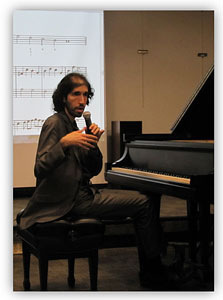Music Educators Association of New Jersey
Serving teachers and students since 1927



An exceptional lecture-demonstration Teaching the Art of Improvisation was presented on January 15th by Dr. Noam Sivan, a composer, pianist, improviser, and conductor.
A faculty member at Juilliard, Curtis and Mannes, Dr. Sivan is a pioneer in the revival of improvisation in the classical music world. He has given evening-length improvised piano recitals; conducted orchestral improvisations; and collaborated on multidisciplinary improvisations with musicians, singers, dancers, and actors.
 In his lecture he presented several ways in which elements of improvisation can enhance the study of a musical instrument, starting with young beginners to the advanced pre-professionals. Dr. Sivan began with the opening phrases of Schumann's Arabesque. His sensitive rendition naturally melted into multiple melodic lines, changing harmonies, texture, keys, moods - in short, an amazing improvisation! Dr. Sivan explained that the ability to improvise is one of the most essential skills for any musician. It helps to develop compositional thinking, connect with one's own musical imagination, acquire harmonic fluency, and attain depth and freedom in interpreting written repertoire. He quoted opinions on improvisation by Bach, Beethoven, Chopin, Busoni, Duke Ellington, and Yehudi Menuhin.
In his lecture he presented several ways in which elements of improvisation can enhance the study of a musical instrument, starting with young beginners to the advanced pre-professionals. Dr. Sivan began with the opening phrases of Schumann's Arabesque. His sensitive rendition naturally melted into multiple melodic lines, changing harmonies, texture, keys, moods - in short, an amazing improvisation! Dr. Sivan explained that the ability to improvise is one of the most essential skills for any musician. It helps to develop compositional thinking, connect with one's own musical imagination, acquire harmonic fluency, and attain depth and freedom in interpreting written repertoire. He quoted opinions on improvisation by Bach, Beethoven, Chopin, Busoni, Duke Ellington, and Yehudi Menuhin.
 In teaching, Dr. Sivan recommended a student-specific approach: "establish a supportive atmosphere, address student's fears, include interpretation of both traditional repertoire and new styles, and disregard wrong" notes or incorporate them into the music. As an example, he showed a video of his improvisation with a 10-year-old girl at one of his presentations. Simple "call and response" soon shifted to more varied improvisations including black keys, chromaticism, and intertwined melodies. Then he showed a video of his class at Juilliard, where a group of students took turns improvising on a melodic pattern by picking-up the last note or a segment of a previous phrase. Next, Dr. Sivan showed his class at Curtis, illustrating elements of skillful improvising: using bass lines as a basis, adding arpeggios and passing tones, using appoggiatura and chromatic progressions, and employing both variety and repetition. Students, at all levels, enjoyed themselves and had fun as they were engrossed in their expressive improvisations.
In teaching, Dr. Sivan recommended a student-specific approach: "establish a supportive atmosphere, address student's fears, include interpretation of both traditional repertoire and new styles, and disregard wrong" notes or incorporate them into the music. As an example, he showed a video of his improvisation with a 10-year-old girl at one of his presentations. Simple "call and response" soon shifted to more varied improvisations including black keys, chromaticism, and intertwined melodies. Then he showed a video of his class at Juilliard, where a group of students took turns improvising on a melodic pattern by picking-up the last note or a segment of a previous phrase. Next, Dr. Sivan showed his class at Curtis, illustrating elements of skillful improvising: using bass lines as a basis, adding arpeggios and passing tones, using appoggiatura and chromatic progressions, and employing both variety and repetition. Students, at all levels, enjoyed themselves and had fun as they were engrossed in their expressive improvisations.
Historically, musicians improvised at the concerts, and compositions included improvisational sections. Pianists/composers would perform their own works until late 19th century, when performing and conducting became specialized, apart from composing. A discussion of a brief history of improvisation followed.
Baroque period: Importance of bass line. Forms - preludes, fugues, suites (Bach). With Corelli - more emphasis on melody and ornamentation.
Classical period: Development of cadenza, prelude, variations. As an example, Dr. Sivan showed an original sketch of the 1st movement of 'Tempest' Sonata by Beethoven, which was just a few main phrases; the rest was improvised and notated later.
Later part of the 19th and the 20th Century - decline of improvisation due to the appearance of the standard repertoire, preparation and striving for 'ideal' performances, fear of taking risks, complexity of musical language, development of recording industry, gap between serious and popular music.
Emergence of free improvisation (1960 - present) - we are in the revival stage of improvisation art: 'Can we learn a language just by reading, memorization, and reciting without speaking?'

At the end of the presentation, by requests of the audience, Dr. Sivan improvised on Beethoven's Appassionata, Tchaikovsky's 1st Piano Concerto, and Happy Birthday in Beethoven's style. His improvisations started in the style of the given composer and then very naturally acquired elements from a multitude of other styles. Dr. Sivan smoothly shifted into complicated structures, fugues, rich orchestral sonorities, performing with beautiful expression and virtuosity. It was a brilliant demonstration. This was an indescribable experience for the spellbound audience. In closing, he played his own beautiful written composition - Prelude in D-sharp minor.
In the following Q&A session, we learned that Dr. Sivan was encouraged to improvise by his professor of Composition at Mannes, Carl Schachter. Dr. Sivan recommended the books, Essay on the True Art of Playing Keyboard Instruments, by C.P.E. Bach and A Systematic Introduction to Improvisation on the Pianoforte by Carl Czerny. He also recommended Monuments of Partimenti, which may be accessed through the portal of Dr. Robert O. Gjerdingen here.

Many of Noam's improvisations can be found on Youtube. Here is Noam improvising on the Goldberg Variations of Bach.
Visit his website for more information: noamsivan.com.
Sophia Agranovich, Program Chair and Hostess